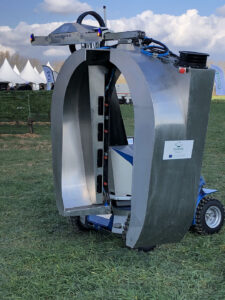Autonomous sprayer robot for vineyards applies variable rates

One of the ag robots making its debut at World FIRA was the Teyme Weta autonomous sprayer robot. It is designed specifically for improving spray application accuracy, efficiency and safety when working in steep vineyards.
The TEYME WETA autonomous sprayer robot is being developed under the scope of the ‘Scorpion Project’ – a consortium of ten research institutes. Batteries deliver 4kW of electrical power to propel the robot, which is said to be able to cover about 4ha/day.
Variable rate spray and UV light treatment

As well as the ability to autonomously negotiate its way through vineyards, the autonomous sprayer robot also introduces some interesting new application technology to the sector, which include variable rate spray and UV light treatment.
To vary the applications is uses real time Lidar and laser vision systems. This data is processed by algorithms to assess the size of the canopy and foliage density to evaluate the dose rate required for each specific area, as it passes.
Spray application rates and UV light intensity can also be varied on the move according to a pre-defined prescription map. At the same time the system gathers data about growth rate and health status of the plants.
Pulse width modulation
Variable rate spray applications are controlled by pulse width modulation (PWM), with each nozzle being individually managed. This enables dose rates to be varied to match the requirements of crop in each specific area.
Airflow from the air assistance fans is also managed and varied in real time to match the volume of liquid being applied and the foliage density.
UV light application
The modular design of the autonomous sprayer robot also enables the spray equipment to be replaced with UV light application. This comprises eight panels, which can also be managed individually to deliver variable rate treatments.
Scorpion Project
Led by INESC TEC, the Scorpion Project brings together two steep slope vineyard associations, robotics and machinery research centres, SMEs as well as TEYME.
The project has received funding from the European GNSS Agency under the Horizon 2020 programme.
The aim of Scorpion is to look at GNSS receivers and frequencies along with other sensors to increase reliability, accuracy and safety as well deliver high precision spraying in permanent crops. This is said to be important for autonomous operations because of the difficulty in receiving reliable signals due to the hilly terrain, natural obstacles as well harsh environmental conditions.
At the same time the project also aims to improve spray efficiency and efficacy, working towards the of objective of applying the ‘right amount of plant protection products at the right time and in the right place.’ The design is expected to result in a saving of 60% in the amount of pesticide applied as well as replace some entirely using new techniques, such as UV light treatments.